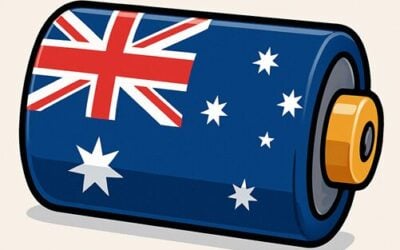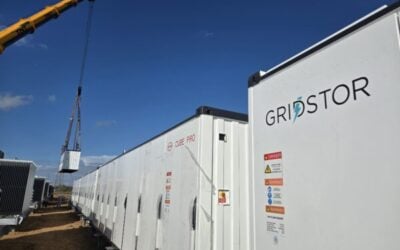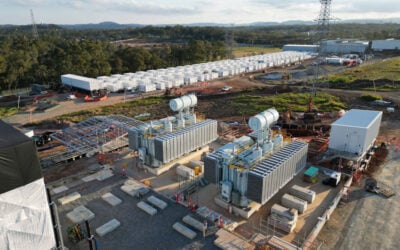
The first 350MW/700MWh of the Waratah Super Battery in New South Wales, Australia, has officially come online, ahead of full operation later this year.
Akaysha Energy developed and owns the battery energy storage system (BESS), which has frequently been described as a “giant shock absorber for the grid” in the event of power line outages.
Once fully operational, the Waratah Super Battery will be 850MW/1,680MWh in size and help prevent blackouts across New South Wales. It completed its energisation process in September 2024.
The utility-scale BESS has already played a major role in preventing blackouts in Australia. In early November 2025, it was drafted to maintain 96MWh of energy storage to the National Electricity Market (NEM) at 15:00 amid surging demand throughout a heatwave. Other BESS assets, such as Iberdrola Australia’s 50MW/75MWh Wallgrove BESS, also helped prevent blackouts that day.
Try Premium for just $1
- Full premium access for the first month at only $1
- Converts to an annual rate after 30 days unless cancelled
- Cancel anytime during the trial period
Premium Benefits
- Expert industry analysis and interviews
- Digital access to PV Tech Power journal
- Exclusive event discounts
Or get the full Premium subscription right away
Or continue reading this article for free
For Nick Carter, CEO of Akaysha Energy, bringing the Waratah Super Battery online represents a significant milestone for the organisation, which is developing several other BESS sites in Australia, such as the 300MWh Ulinda BESS in Queensland.
“This achievement is the result of a tremendous collective effort spanning our global business units across all areas such as delivery, engineering, commercial and legal, technical integration, grid modelling, software, operations and trading,” Carter said.
“Delivering this scale of infrastructure on such an accelerated timeline is no small feat, and we are honoured to have been entrusted to deliver a project of such significance to New South Wales’ energy security.”
How does the Waratah Super Battery function as a ‘giant shock-absorber’?
Akaysha Energy, acquired by global investment powerhouse BlackRock in 2022, won the contract to deliver Waratah later that year through state-owned corporation EnergyCo.
Akaysha, in turn, appointed US-headquartered Powin Energy as the project’s BESS provider, which recently filed for Chapter 11 bankruptcy after admitting it struggled to compete with Chinese OEMs’ integrated BESS offerings.
Through the partnership with Powin Energy, Spanish power conversion system (PCS) and power plant controller (PPC) specialist Eks Energy (EKS) was also employed to support the development of the BESS.
At its core, the Waratah Super Battery Project is designed to optimise the capacity of transmission lines supplying electricity to the Hunter, Sydney and Illawarra regions of New South Wales.
This is achieved via the largest System Integrity Protection Scheme (SIPS) in Australia, which enables transmission operator Transgrid to send signals to the BESS to inject energy into the grid while simultaneously instructing paired generators to adjust their output.
Specifically, the SIPS Control System can monitor 36 transmission lines in real time and respond instantaneously to system events.
This dynamic balancing act prevents disruptions and allows existing transmission infrastructure to operate at higher capacities, effectively “running harder” without compromising reliability.
Through the SIPS, the Waratah Super Battery will also serve as a stopgap measure until the Hunter Transmission Project – a major infrastructure initiative to connect inland Renewable Energy Zones (REZ) to the rest of New South Wales – comes online.
This major infrastructure project will see the construction of a new overhead 500kV transmission line spanning around 100km between Bayswater in the Upper Hunter and Olney in the Lower Hunter. It is hoped that this project will be completed by early 2028.
In the meantime, the Waratah Super Battery will also play a role in stabilising the grid and reducing wholesale electricity prices by discharging energy during periods of high demand.
Although the Waratah Super Battery was claimed in a NSW government statement today to be the “world’s most powerful battery in terms of power and energy storage capacity,” this appears to be inaccurate if judged based on megawatt-hours capacity onsite. The Edwards & Sanborn solar-plus-storage project in California, currently holding the unofficial ‘largest BESS project in the world’ title, features a 3,287MWh BESS and came fully online in early 2024.
A representative from Akaysha Energy told Energy-Storage.news that although the Edwards & Sanborn BESS’s megawatt-hours capacity is larger than that of the Waratah Super Battery, in terms of power output, Waratah is higher, at 850MW compared to 821MW.
The Waratah Super Battery is, however, now the largest operational BESS in Australia, surpassing the 300MW/450MWh Victorian Big Battery and the first stage of the 270MW/540MWh Western Downs BESS in Queensland.
Our publisher, Solar Media, will host the Battery Asset Management Summit Australia 2025 on 26-27 August in Sydney. You can get 20% off your ticket using the code ESN20 at checkout.





